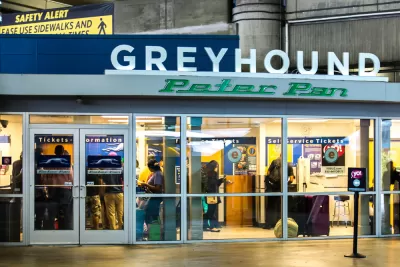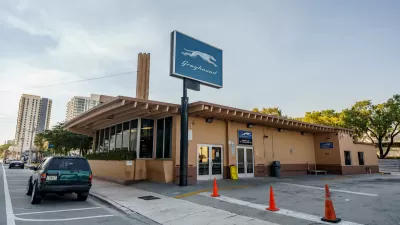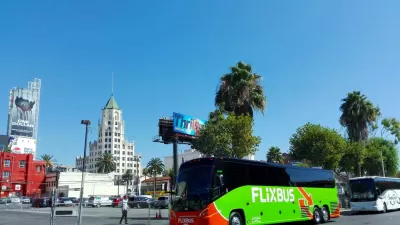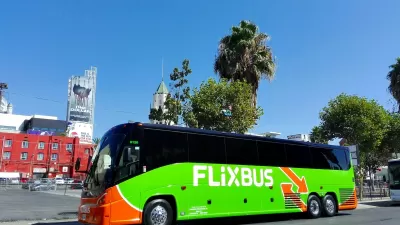Like train stations, Greyhound stations can be tolerable urban places- or they can be another example of suburban sprawl.

Over the past decade, I have been to about 40 Greyhound bus stations—usually to visit a city, sometimes just for a layover on the way to my home or to a city I was visiting. I have noticed that just as some train stations are better urban places than others, some bus stations are better urban places than others. Obviously, not all bus stations are equally nice—some are clean, some are dirty; some are overcrowded, others have ample seating. Northern cities with lots of bus travel have more demographically diverse clienteles, while southern stations tend to have more down-and-outers. New York's Port Authority bus station benefits from restaurants and other amenities, but smaller stations usually have nothing but a few vending machines.
Another way in which bus stations vary is their external environment. The best bus stations, like the best train stations, are in the heart of downtown, so that riders can easily reach a wide range of destinations. For example, Boston buses run out of South Station, which is also both a major rail hub and reasonably close to the central business district. Even some small-city bus stations are fairly centrally located; for example, Buffalo's bus station is also a block from Main Street (downtown’s major commercial street) and is the hub for most regional buses.
A second pattern is for stations to be at the fringes of downtown, usually near a highway and near the city's less desirable neighborhoods. For example, Atlanta's station is at the southern edge of downtown, near the city jail. Although the station is only about a 10-minute walk from downtown, the walk is not particularly fun during the day, and I don't think I would even try it at night. Similarly, Nashville's bus station is three or four blocks from major downtown attractions, in an area that feels slightly more rundown than downtown. Orlando's bus station goes a bit further in the wrong direction: it is three miles from downtown, in an area that seemed to me to be one of the city’s tougher neighborhoods.
The least desirable pattern is for Greyhound to maximize highway access and to abandon downtown completely. For example, in Memphis the station is near the airport, on a block with a Walkscore of 27—pretty dreadful for a business that caters to non-drivers. But at least the station has regular (by Memphis standards) bus service. In Chattanooga, the bus station (also near the airport) is served by a city bus that runs only once every 90 minutes or so. Less patient riders have the option of walking along Airport Road (which has no sidewalks) for about 15 minutes to reach another bus route. In suburban Atlanta, the Marietta bus station adjoins a road with only intermittent sidewalks (Highway 41).
In sum, the best Greyhound stations are not merely clean and well-managed, but in the heart of the city. The worst are just another piece in the jigsaw puzzle of suburban sprawl.

Maui's Vacation Rental Debate Turns Ugly
Verbal attacks, misinformation campaigns and fistfights plague a high-stakes debate to convert thousands of vacation rentals into long-term housing.

Planetizen Federal Action Tracker
A weekly monitor of how Trump’s orders and actions are impacting planners and planning in America.

In Urban Planning, AI Prompting Could be the New Design Thinking
Creativity has long been key to great urban design. What if we see AI as our new creative partner?

King County Supportive Housing Program Offers Hope for Unhoused Residents
The county is taking a ‘Housing First’ approach that prioritizes getting people into housing, then offering wraparound supportive services.

Researchers Use AI to Get Clearer Picture of US Housing
Analysts are using artificial intelligence to supercharge their research by allowing them to comb through data faster. Though these AI tools can be error prone, they save time and housing researchers are optimistic about the future.

Making Shared Micromobility More Inclusive
Cities and shared mobility system operators can do more to include people with disabilities in planning and operations, per a new report.
Urban Design for Planners 1: Software Tools
This six-course series explores essential urban design concepts using open source software and equips planners with the tools they need to participate fully in the urban design process.
Planning for Universal Design
Learn the tools for implementing Universal Design in planning regulations.
planning NEXT
Appalachian Highlands Housing Partners
Mpact (founded as Rail~Volution)
City of Camden Redevelopment Agency
City of Astoria
City of Portland
City of Laramie






























